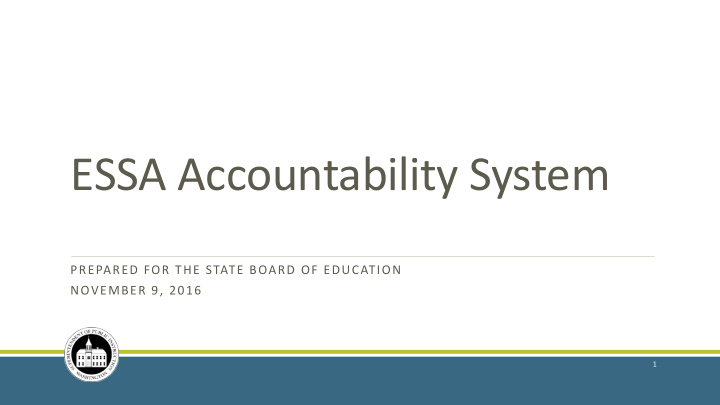



ESSA Accountability System PREPARED FOR THE STATE BOARD OF EDUCATION NOVEMBER 9, 2016 1
What are some of the changes in the shift to the Every Student Succeeds Act? No Child Left Behind Act Every Student Succeeds Act 100% Proficiency Standard Emphasis on Growth and Gaps School Failure Letters Home Schools Identified for Support “Highly Qualified” Requirement Effective Educators SES Set-Asides and School Choice Local Control on Spending Required School Turnaround Models LEA and SEA Improvement Models Cascading Sanctions LEA School Supports 2
Accountability School Quality or Student Success Academic Indicators Middle Elementary English Learner Proficiency Growth Progress Chronic Absenteeism School Chronic Absenteeism English Learner Proficiency Growth Progress Chronic Absenteeism School High English Learner Proficiency Graduation Rate 9th Graders on Track Progress Advanced Course-Taking (dual credit) 3
Accountability School Quality or Student Success Academic Indicators Middle Elementary English Learner Proficiency Growth Progress Chronic Absenteeism School Chronic Absenteeism English Learner Proficiency Growth Progress Chronic Absenteeism School High English Learner Proficiency Graduation Rate 9th Graders on Track Progress Advanced Course-Taking + Industry Certification Additional measures will be considered for Phase 2: disproportionate discipline, teacher assignment and equity, 4 and a school climate and engagement survey
Indicators: weighting priority by category and grade band EL Proficiency Growth Graduation SQSS Progress Elementary Medium High Med-Low Low Middle Medium High Low Low High Med-High High Low Low 5
Identification for Comprehensive Support Schools will be identified for Comprehensive Support based on the All students group in combination with targeted subgroups. (lowest 5 percent) This approach emphasizes the importance of targeted subgroups’ performance. The Achievement and Accountability Workgroup shall review data and consider different methods for the calculation (weights and proportions) in order to balance the importance of historically underserved populations but not skewing outcomes for schools with large populations of those students. 6
Race & e & Programs ms Targeted Ethni nici city y Support t Bottom 10% of Targeted Subgroups Identified Consistently Underperforming (combined and stacked) Race/Ethnicity Subgroups and Programs 7
8
Long-Term Goals for High School Example: ELA 100% 80% Percent Meeting Standard 60% 40% 11th graders of 2026 - Minimum Proficiency Rate for all student groups: 90% 20% 0% Black / African American American Indian / Alaskan Native Asian Hispanic / Latino Native Hawaiian / Pacific Islander White Two or More Students with a Disability Limited English Low-Income 9
Long-Term Goals for High School On-Time Graduation Rate 100% 80% Percent Graduating 60% Class of 2026 -- Minimum Graduation Rate for all student groups: 90% 40% 20% 0% Black / African American American Indian / Alaskan Native Asian Hispanic / Latino Native Hawaiian / Pacific Islander White Two or More Students with a Disability Limited English Low-Income 10
Projected Timeline 11
Contacts: Dr. Gil Mendoza, Deputy Superintendent Maria Flores, Director K-12 Education Title II, Part A and Special Programs Office: 360-725-6359 Office: 360-725-6343 Email: maria.flores@k12.wa.us Email: gil.mendoza@k12.wa.us Dr. Deb Came, Assistant Superintendent Assessment and Student Information Office: 360-725-6336 Email: deb.came@k12.wa.us 12
Recommend
More recommend